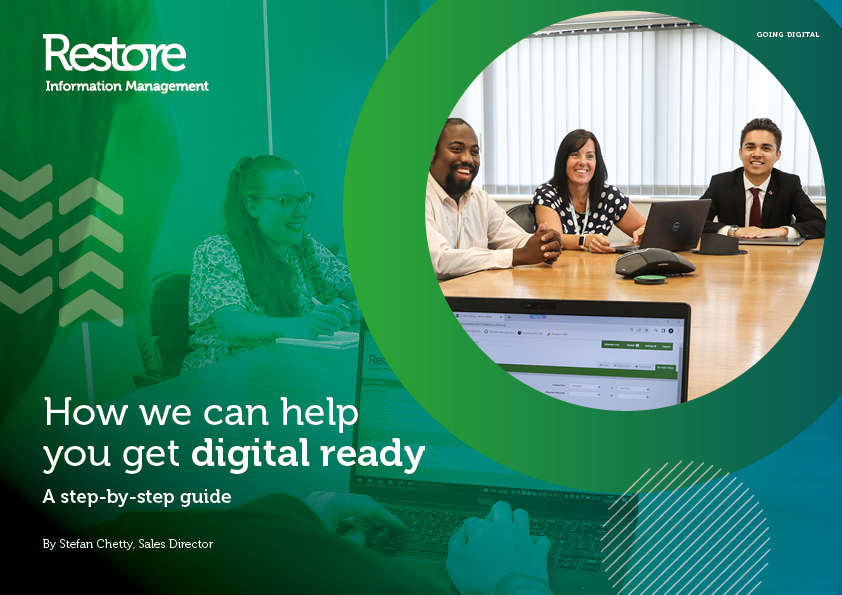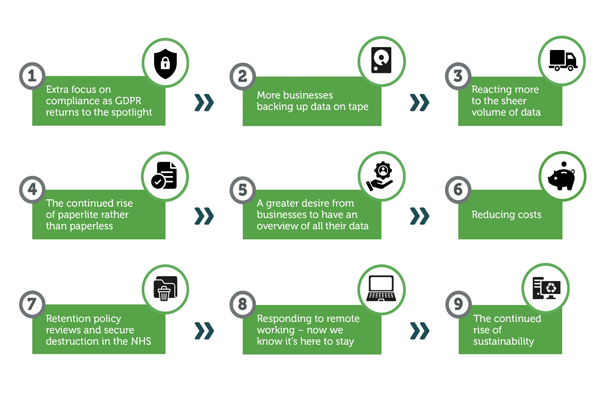
Hybrid solutions and a paperless NHS
Are hybrid and paperlite solutions the key to the age-old dream of a paperless NHS?
In the quest for a paperless NHS, a surprising revelation is emerging in 2023: the coexistence of digital and paper records can revolutionise patient care with unparalleled efficiency.
If that sounds like a disappointing ‘big reveal’ for those who dreamt of an entirely digital service by 2020, then it shouldn’t do – because it’s a solution rooted in reality and one which sets us on a smoother path to a digital future.
Stefan Chetty,
Digital Services Director, Restore Information Management
Digitising NHS records is a challenge
For most trusts, the sheer volume of records makes scanning everything cost-prohibitive, with the majority housing over a million records, and the larger ones considerably more. Our estimate, based on our wide experience of working in the sector, is that reliance on paper in the NHS has reduced from around 70% to almost 50%, but it certainly hasn’t gone away.
The focus has been on ‘going digital’ but there’s a middle ground to aim for. For the majority of Trusts, it would cost tens of millions of pounds to scan all their documents at a cost of £10-£15 a record, when all costs are considered.
Even some of those who in the past wanted to be exemplars of going digital didn’t think about data capture. Many scanned records to view as a PDF on a screen but the result was often more clunky than a paper folder – scrolling through a 200-page PDF isn’t always easy.
A scan-on-demand or ‘digital delivery’ service is better and more cost-effective – because many records stored are never or rarely needed. The key lies in a pivotal shift where clinical staff gradually break free from paper records.
As a result, many trusts are now embracing progress rather than abandoning paper altogether, allowing for the harmonious coexistence of physical and digital records.
The role of interoperability in digital transformation
One of the fundamental challenges in optimising patient record storage is interoperability – the ability for different IT systems to communicate and share data efficiently. Without seamless integration between electronic health record (EHR) systems, data silos can hinder patient care and efficiency. According to NHS Digital, the implementation of standards like DCB0129 (Clinical Risk Management for Health IT Systems) ensures that patient data remains accessible and secure across platforms. This is why accreditation and adoption of these standards are so important – find out more about Restore Information Management’s credentials and what these mean here.
To maximise interoperability, trusts should prioritise solutions that integrate with NHS Spine services, allowing real-time data exchange between healthcare providers. Standardised metadata tagging, automated indexing, and cloud-based repositories further enhance access and retrieval speeds while maintaining compliance with NHS Information Governance standards.
AI and automation in record management
Emerging technologies such as artificial intelligence (AI) and robotic process automation (RPA) are playing a critical role in patient record management. Classification tools can analyse and categorise scanned documents, ensuring that key patient information is indexed accurately. RPA can automate routine administrative tasks, such as updating patient records and flagging missing data, reducing the burden on healthcare professionals and improving overall efficiency.
For example, deploying Optical Character Recognition (OCR) technology can transform legacy paper records into structured, searchable data, reducing manual input errors and streamlining clinical decision-making. Recently, advances in AI have also bolstered this technique’s effectiveness – learn more about how we use it here.
Cybersecurity and data protection
As healthcare providers move towards digital records, data security remains a top priority. Trusts must comply with regulations such as the Data Security and Protection Toolkit (DSPT) to safeguard patient information against cyber threats. Implementing robust cybersecurity measures – including multi-factor authentication, encryption, and real-time monitoring – can help mitigate risks associated with digital transformation.
Furthermore, trusts should conduct regular audits to identify vulnerabilities in their record storage systems and invest in staff training programmes to raise awareness about data protection best practices.
Successful implementation
We are seeing examples of this all the time, including our projects with University Hospitals Coventry and Warwickshire, Hillingdon Hospitals NHS Foundation Trust, South Tyneside and Sunderland NHS Foundation Trust and County Durham & Darlington NHS Foundation Trust. (CDDFT).
Best practices for optimising patient records
Keeping patient records organised is in line with compliance, but it’s also about making life easier for healthcare professionals and ultimately ensuring patients get the best care possible. The best way forward? A hybrid approach that combines structured offsite storage, selective digitisation, and automation. This method is proving to be the smartest, most cost-effective way for NHS Trusts to manage records efficiently without overwhelming budgets or staff.
- Structured offsite storage: Moving records offsite can free up valuable clinical space while ensuring compliance with GDPR and NHS retention policies. Using an accredited records management provider ensures secure access and retrieval processes.
- Standardisation of record-keeping practices: Implementing consistent record-keeping protocols, including structured metadata tagging and barcode tracking, reduces the risk of misfiled or lost records.
- Integrated digital workflows: A phased approach to digitisation, where new patient records are created digitally while legacy records are transitioned gradually, minimises disruption and maximises efficiency.
- Automated record auditing: Leveraging automated systems to track record retrieval, retention timelines, and compliance metrics can significantly enhance record management efficiency.
- Clinic preparation optimisation: Establishing automated file request systems, where patient records are retrieved ahead of scheduled appointments, ensures timely access to critical patient data and reduces administrative burden.
- Minimising duplicate records: Using AI-powered deduplication tools can help eliminate redundant records and ensure that clinicians have access to the most up-to-date patient information.
A bespoke approach
In the end, finding a cost-effective approach to manage patient records while enhancing patient care is the priority – for which there’s no one-size-fits-all solution.
Each trust has unique challenges and legacy systems to address. However, for trusts grappling with significant paper inventory, embracing a hybrid model is a powerful step towards becoming ‘digital ready’ for the future.
The future of patient record storage
Looking ahead, the NHS Plan for Digital Health and Social Care sets ambitious targets for a more digitally integrated healthcare system by 2026. Their key initiatives include:
- Expanding the use of electronic patient records (EPRs): By 2025, all NHS trusts are expected to have fully operational EPRs.
- Enhancing patient access to health data: Patients will have more control over their medical records via NHS App integrations.
- Leveraging predictive analytics: AI-driven insights will help forecast patient outcomes and optimise resource allocation.
For healthcare providers, the key to success will be continuous investment in scalable digital infrastructure while ensuring alignment with NHS digital transformation roadmaps.
Cost-effective solutions and real-world impact
A hybrid record management strategy is already delivering significant benefits across the NHS. Offsite storage and scan-on-demand services are increasingly preferred over full-scale digitisation, offering flexibility while controlling costs.
For example, at County Durham & Darlington NHS Foundation Trust (CDDFT), over 900,000 patient records were stored across five locations, requiring a centralised approach. By partnering with Restore Information Management, the trust successfully implemented a structured hybrid system, combining scan-on-demand services and optimised storage solutions. This led to:
- A reduction in daily retrieval volumes from 2,000 to 42 files, streamlining workflows.
- Increased clinical space by relocating paper records offsite.
- A centralised digital system that improved record access, coordination, and decision-making.
- Cost savings, with reinvestments directed towards frontline patient care.
Looking ahead: a sustainable digital transition
A paperless NHS remains an ambitious goal, but optimising patient record storage through hybrid solutions, interoperability, AI-driven automation, and robust cybersecurity measures ensures that progress is made in a pragmatic and sustainable way.
By adopting a strategic approach, NHS trusts can improve efficiency, reduce costs, and enhance patient care while positioning themselves for the future of digital healthcare.
Looking to adopt a paperlite, hybrid approach? Find out how we can help you.



